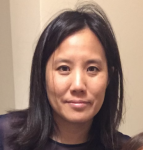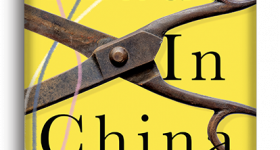If you miss museum visits during the quarantine, books with visuals and artifacts have become options for reconceptualizing the experiences museums offered. The recently published Voices from the Railroad, co-edited by Sue Lee & Connie Young Yu, pairs historical documents and photographs with stories about Chinese railroad workers told by their descendants. The editors agreed to connect me with some of the descendants whose stories form the book’s historical lenses through email interviews. Part I of the interviews appears this week, and Part II appears next week. Each interviewee describes how they came to be involved in the making of this book and what motivated and helped to generate their research. The following interviews have been edited for length and clarity.
Evelyn Ch’ien (Hyphen): What motivated you to explore your family history?
Andrea Yee: As a 4th generation Chinese American, I always felt like an outsider. The Chinese Exclusion Act that prohibited immigration from China, which lasted more than 60 years from 1882 to 1943, was still the law when I was a child. Decades later the fear of deportation still reverberated and silenced my parents and their community from any expression. For many generations this law gave permission to mistreat not only Chinese, but all nonwhite immigrants. Finally, in the 1960s, the African Americans in the Civil Rights movement inspired us with their relentless courage. They paved the way for our Asian American arts community to seek out our own hidden stories — the real history of how we all built this country on our backs.
Russell Low: This represents part of a 30-year personal journey that began with a desire to tell my infant son about his roots. I started with very little except my curiosity and perseverance. I ended up with courageous family stories about a teenage Transcontinental Railroad worker and a rescued child slave. These were my sons' great-great-grandparents.
Connie Young Yu: In my family, discussions about our immigration past were unavoidable. I have been on [the subject of the Transcontinenal Railroad] since 1969, the Centennial celebration at Promontory, when my mother was the only descendant present at the ceremonies, and Philip P. Choy, the president of CHSA, was denied his place on the program. Phil started the movement, and I, as commencement speaker at the 150th, was there to fulfill his mission, to put “Chinese on the map.” In the book Voices from the Railroad I write about my 50 year journey as descendant of a Chinese railroad worker in the essay "Lee Wong Sang, Making Tracks to Follow." Without a doubt, I owe my vocation, my lifelong cause, to both my mother and father, who each provided me with stories of their childhood — and their parents’ respective childhoods — [who documented] their struggle to stay in America [and] the sacrifices [they made] for [their] family, with photos, memorabilia and documents saved under duress. The rest I filled in with archival research in libraries and NARA (National Archives and Records Administration) in San Bruno, finding reams of immigration testimonies of my relatives detained for questioning on Angel Island.
Vicki Tong Young: Our family heirloom is a gold Swiss watch given to my great-grandfather in 1875 in honor of his excellent work as a Chinese headman and labor contractor for the Transcontinental Railroad and later. I always heard family stories, but I wanted to discover the truth of who my great-grandfather was so I could pass this along to my grandchildren and children as their legacy.
Paulette Liang: I wanted to corroborate the oral history passed down on my mother's side of the family.
Carolyn Kuhn: On April 18, 2013, I received an email request from a reporter Jeff Han (Han Jie). He wanted to write a story about “the unknown Chinese Laborers who helped to build the great American nation’s road.” He wrote stories for the World Weekly, which he said was a supplement to the Sunday’s World Journal and said they were the largest Chinese language newspaper in North America with 1 million readers. He added that “our readers include Chinese premier Jiabao Wen.” This is when it became important for me to begin research about the history of the Chinese railroad builders.
EC (Hyphen): What was the most surprising discovery you made about your family?
Andrea Yee: I found several surprises in the remarkable life of my great-grandfather, Lim Lip Hong, who lived throughout the most turbulent era of violence and racism against Chinese Americans. My mother quoted [my great-grandfather] as saying, “We will have world peace when we learn that people are all the same no matter what is the color of skin.” His lifelong work on the railroads with Whites, Blacks, Latinos, Asians and especially with the Native American tribes taught him that this was possible. Imagine my great-grandfather’s surprise when his eldest son, Lim Sing, my grandfather, pleaded in a meeting amongst the despairing Chinese left homeless [during the 1906 San Francisco earthquake] to return and rebuild immediately the devastated Chinatown against the orders of the San Francisco mayor to remove all Chinese permanently from the city. Lim Sing stood up and firmly exhorted, “We have the constitution on our side.” Mayor Schmidt’s plan backed down within three months and to this day, San Francisco Chinatown still stands in its original location, newly rebuilt. My second surprise was to learn that Huntington, one of the Big Four Bosses (EC: This term applied to the four tycoons and philanthropists who funded the construction of the Central Pacific Railroad, including Leland Stanford, Collis Potter Huntington, Mark Hopkins and Charles Potter), wanted to acknowledge the railroad builders’ sacrifices in a small way. He chose to pay 100 of his most loyal workers one dollar a day for the rest of their lives, Lim included. The gesture must have had its impact on Lim and his children as they also left stories that deemed loyalty, generosity and sacrifice above profit.
Russell Low: The love story of my great-grandparents Lai Wah and Ah Ying was unknown to my family. How he helped to have her rescued from her life of slavery, only to have the missionary matrons forbid her from marrying him, is an incredible story. The research and passion for storytelling led to a book entitled Three Coins in which these two tell their own stories. (See https://www.russlow.com.)
Connie Young Yu: Not a surprise, but it amazes me that my grandpa Young was a revolutionary, a supporter of Sun Yat-sen when Sun was a fugitive. Documents attested to this in Chinese, which I didn’t know about earlier. There was such courage and sacrifice, the brilliant networking and organization of the revolutionary party in the United States. This is the little-known part of our history that shows the profound character of our oppressed, laboring ancestors — they were idealistic and political, many brilliant and courageous and inspiring.
Vicki Tong Young: I was amazed to discover that my great-grandfather and my grandfather, whose wives were left behind in China due to the Chinese Exclusion Acts, never got to see their sons born before they had to leave China to return to the United States. My great-grandfather beat the cutoff date by a month. He never met his son until he saw him at Immigration in San Francisco at age 18 and they recognized one another by their pictures. My father lived in China without his father, who was working in California, until there was an unsuccessful kidnapping against him as a “Gold Mountain” scion at age 8. His mother tearfully cabled her husband to return to China to bring their only child to the United States. Due to the Exclusion Laws, my father grew up in Los Angeles Chinatown motherless, and he never saw her again. There were generations of broken families among the pioneer Chinese Americans.
Paulette Liang: The most surprising discovery was the documents about my great grandmother, Low Sam. They were stored at the national archives in San Bruno, Calif. The interrogations by the INS when she traveled to China in the 1900s revealed information we had not previously seen.
Carolyn Kuhn: Chin Lin Sou, a leader in building the Transcontinental Railroad, was a first-generation Coloradan. It is notable that generation four differed much from the earlier generations. Before that, the older generations married among the Chinese people. In fact, marriages between Chinese to Chinese now is unusual. Intermarriage among races in our family is now the norm.
EC (Hyphen) : What is the most valuable artifact you own and why?
Andrea Yee: The only artifact from my great-grandfather’s time is a straw hat sitting on my shelf, perhaps the same one or a reproduction, that he holds in his hand in a photo with his railroad crew building the transcontinental railroad in the 1860s. Another artifact is a 1907 photo of an award by the Qing Dynasty Emperor Guangxu granted to my grandfather Lim Sing for his leadership in saving San Francisco Chinatown after the earthquake in 1906.
Russell Low: We treasure the 1903 photograph of my great-grandparents in San Francisco with their five children dressed in Chinese costume. Beyond that photograph is a less tangible gift: the courageous spirit or independence and defiance that these early Chinese American immigrants passed on to their descendants. This spirit is alive today in each of us.
Connie Young Yu: I have a lot of precious documents that meant life itself to the holder. The most important one is my grandfather Lee Yoke Suey’s birth certificate, proof he was a native-born American [and] which he risked his life to save after the earthquake and fire of ’06. It has the signature in English of his father, my great-grandfather Lee Wong Sang, who was a foreman for the Central Pacific Railroad. But truly the most valuable artifact I own is my father’s World War II diary, [which] includes day-to-day entries of his 31 months at the front [as] a U.S. Army officer (Lt. to Major) in the China-Burma-India theater of operations under the command of Gen. Joseph Stilwell.
Vicki Tong Young : Our most cherished artifact is our great-grandfather’s 1875 Swiss gold watch, engraved with his name, Mock Chuck, and the name of the railroad official who presented it to him in appreciation of the many years he worked on the Transcontinental Railroad from 1866 over the Sierra Nevada Mountains to the Southern Pacific Railroad from Bakersfield to Los Angeles. He was a Chinese headman and one of the leading railroad contractors who hired hundreds of Chinese to build the tunnels and tracks all the way to Texas. Later, he became a business partner of Jim Mock, the Chinese man hired by Leland Stanford to be the head groundskeeper of his vast estate and farm, when he opened a store in San Francisco.










Comments